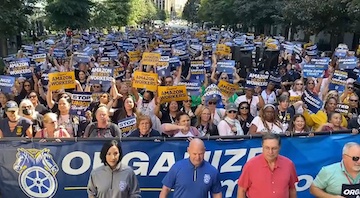As a company forged under the branding iron of reinvention, Amazon has always hoped to create the prototype of a different kind of company that offered its workers a different kind of employment experience and employee benefits package.
The roadmap for that forward-thinking philosophy has found itself on a collision course with the realities of time and scale. The crash course spilled over onto the streets of Seattle this week as Teamster union members and leaders rallied outside the company’s Seattle headquarters delivering loud chants in protest of Amazon and its founder, Jeff Bezos. Teamsters organizers, including Sean O’Brien, general president of the union, brought their campaign to organize Amazon warehouse and logistics workers literally to the company’s front door.
As the second-largest American employer and the largest American e-commerce retailer with over one million workers, Amazon’s warehouse labor practices have been subject to continued scrutiny, including challenges to the company’s work conditions, rising injury rates, worker surveillance, and efforts to block unionization.
Despite increasing its minimum wage to $15/hour, providing healthcare benefits and COVID-19 testing, labor advocates and government officials have been critical of Amazon’s warehouse working conditions. While unions are common among Amazon warehouse workers in Europe, few of Amazon’s American workers are unionized. The company has actively opposed unionization in the United States, having stated a preference to resolve issues with employees directly, and asserting that unions would impede the company’s innovation. Prior to a 2020 union drive in Bessemer, Alabama, Amazon had not faced a major union vote in the United States since Delaware in 2014.
Milestones in the Unionization March
On April 1, 2022, the National Labor Relations Board announced that Amazon workers at the JFK8 warehouse in Staten Island, New York City voted to approve the union. 2,654 voted in favor of a union while 2,131 voted against a union. As of April 2022, the JFK8 warehouse is currently Amazon’s only unionized workplace in the United States.
On December 22, 2021, Amazon agreed in a settlement with the NLRB to allow more easily the 750,000 employees in the US to organize including allowing workers to be on property for longer than 15 minutes before and after their shifts for union organizing purposes. Since the beginning of the Corona pandemic, more than 75 complaints have been lodged against Amazon according to the NLRB.
In 2000, the Communications Workers of America and the United Food and Commercial Workers launched unionization drives for Amazon workers after unrest over a number of layoffs and a significant drop in employee stock options. In response, the company set up a section on its internal website giving advice to managers on how to spot workers attempting to organize and how to convince them not to do so. In 2001, 850 employees in Seattle were laid off by Amazon after a unionization drive.
The Washington Alliance of Technological Workers (WashTech) accused the company of violating union laws and claimed Amazon managers subjected them to intimidation and heavy propaganda. Amazon denied any link between the unionization effort and layoffs.
Technical Amazon workers held the company’s first unionization vote in the United States in January 2014, which failed 21 to 6. The NLRB held the vote following a December petition from International Association of Machinists and Aerospace Workers on behalf of 30 Amazon warehouse maintenance and repair workers in Middletown, Delaware.
Throughout the late 2010s, warehouses in Staten Island and Minnesota participated in union drives and bargaining. Workers organized for work conditions in particular, such as need for more frequent breaks. Workers have leaked Amazon manager training videos about discouraging labor organization. In response to changes following Amazon’s 2017 acquisition of grocery Whole Foods, workers began to organize as Whole Worker.The Retail, Wholesale and Department Store Union began to organize 2,500 workers from Amazon’s Staten Island warehouse in December 2018, but this did not result in a union vote.
When other businesses shut down during COVID-19 pandemic safety measures, the welfare and salary of workers ensuring the delivery of goods, including Amazon’s labor, received renewed attention. Amazon workers, amid increased demand, advocated for pay increases and safety measures through work stoppage including walkouts and not appearing for work. Amazon increased pay for warehouse, transportation, delivery, and store workers and increased paid time off. Some workers described these concessions as a minimum for convincing employees to risk working during the pandemic. Amazon responded to worker activism by increasing anti-union propaganda, firing organizers, hiring Pinkertons, and surveilling its workers. In December 2020, the National Labor Relations Board found merit to a complaint that a Staten Island warehouse worker’s firing was an illegal retaliation for organizing for pandemic safety procedure.
Teamster Delivery Service Partners – A Speed Bump
Amazon’s 158,000 DSP drivers are subcontracted across 2,500 companies spanning eight countries, such that Amazon can drop any one provider whose workers unionize. One DSP provider’s Michigan office closed within a month of its workers voting to organize. Amazon supplies subcontracted companies with financing and surveillance technology to track driver movements in real time. The subcontracted companies, in turn, handle workplace management and liability, insulating Amazon. After the Michigan example, Amazon advised other DSP firms on how to avoid union drives, which proved successful through early 2021.
Following the failed drive, the major labor union Teamsters resolved with near unanimity to organize Amazon warehouse and delivery workers as a central focus. Still the sheer number of delivery companies that operated as independent contractors makes unionization difficult. The Teamsters have launched an Amazon Division dedicated to uniting Amazon employees. [24×7]





















